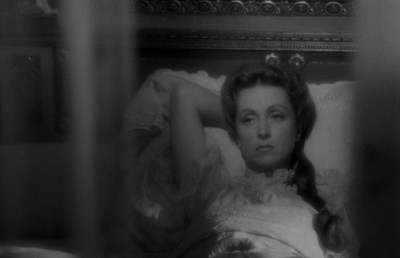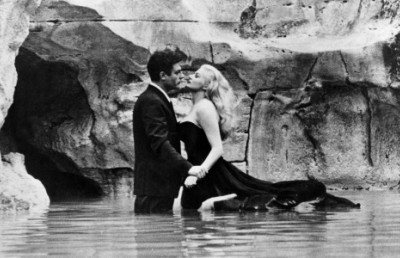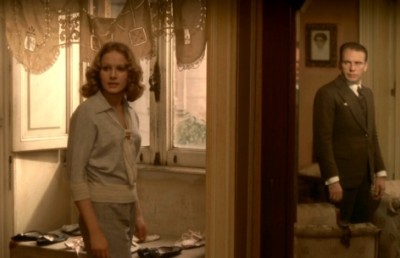The Gaps and Detours in Madame de… Part 1: The Enigmatic Body
Cinema as a revealing and dangerous disease: The virus of the desire for “something else”
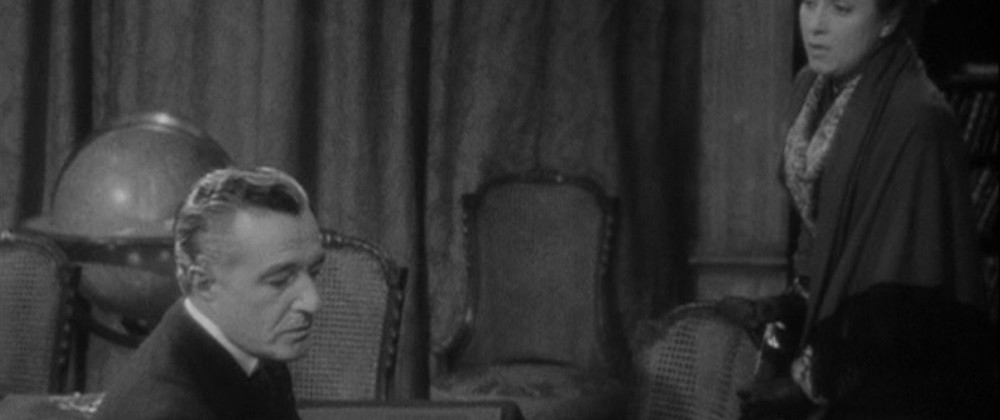
The world and its shadows rise up before our eyes, initiating in us the experience of those unrepeatable movements. (Schefer, 2009: 116)
A form of Poetic CognitivismFrench writer and theorist Jean-Louis Schefer (1938-) writes that “I—the individual spectator, the ordinary person—celebrate my enigmatic being, forever mutating with and within a cinematic world” (Vaughan 162). Schefer believes that cinema is aimed at a part of our subjectivity that is usually condemned to the impossibility of expressing itself – our enigmatic body – and that is precisely the reason why cinema holds the possibility of glimpsing the most hidden parts of ourselves. Through what the visible and the concrete reveal of the invisible, cinema is a sensitive and transforming membrane that summons in the spectator a tortured and ignored being, repressed by the codes of reason and representation that society has imposed on us since the beginning of our existence. This is the enigmatic body, as Schefer has named it. The enigmatic body isn’t actually body or mind, “but instead is the mutability with which we engage a medium bent on constant change” (Vaughan 151). It is a mysterious element, a pre-existing force within us that only comes to life and takes its shape in the encounter with its revealing agent, its developer, that incites a change in us and that is constantly in mutation. Cinema essentially consists of transformation, and it is in this quality of a permanent, unpredictable and intense unravelling that we find the source of our enigma. Just as the film developer’s chemical does not act immediately and homogeneously, such is the rhythm of the expression of feelings. It is not evenly dosed, but instead unpredictably punctuated by the slips that happen sometimes on the surface of life. The same happens in the cinematographic world. This is a universe that evolves “spontaneously under our eyes, it is a continued creation” (Beylie 31) that influences us in an insistent manner with the irregularity of its movements of revelation/omission and presence/absence. It is a continued creation because it does not stand still, it changes within its structure by being viewed in different ways in each of the (re)viewings, and by stepping further into my being and continuing its work in the core of my subjectivity and individuality.
This enigmatic body that got lost amid the codes of reason and representation is now condemned to aphasia and, stimulated by something in the image, finds a breach that allows him to reach the surface. This “something” is what escapes representation but paradoxically needs it to stand out before our eyes. Pressed among the several logical pieces of causality and progression the “something,” the unnameable piercing arrow, emerges. This unnameable thing that meets our enigmatic body is something of “excess,” something outside the textual domain that dodges the analytic scheme and emerges as an inexplicable accident – it is what remains beyond the system and insists in such an intensive way that it has a symptomatic effect on us.
The truth is verified in me alone, “but not by final reference to reality; it is, first of all, only a change in the proportions of the visible whose final judge I will doubtless be, though I’ll also be its body and its experimental consciousness” (Schefer, 2009: 199). The mysterious signs which I receive clash with my own enigma, with the unvoiced that grows as we live, that deep obscure piece inside of us that tries desperately to turn into something visible and comprehensible. In this situation, cinema comes along as a mirror where our most enigmatic and founding secrets are revealed before our eyes. Stimulated by the mental universe’s mirror, the enigmas begin to ascend from the confines of the subconscious and to meddle in the usual organization of the conscious, causing shock and disorder of the senses (which can be revealing, as well as painful).
The cinematographic experience is entirely inseparable from the individual’s history, the ensemble of his affections and his memory. I am part of the image, I am its virtual pole, I am its ghost – the image, in its development, its mutation, spreads to me and changes me. It leaves its traces on me and I give another meaning to that look, that silence, a meaning that was always there but that, paradoxically, only exists because I perceive it. This is a meaning born out of the insistence of my look, of its persistence to dig beyond the apparent. Osmosis happens between the image and the spectator in the encounter of our desires and memories with the real of the image.
In this spectatorial experience, we live in the “dreamer’s duality,” as Schefer explains, between the affection of the image and our own internal memory. This is precisely why the revealing power of cinema can be dangerous. It reconnects us with our most truthful and hidden self (recalling the Room in Tarkovsky’s Stalker) and it is in this collision that we realize the abysmal and growing aphasia in which we fell. This crash can be so strong, leading us to a place within us so profoundly essential and deep, that we may very well take the risk of never coming back. Absorbed by the mysteries of our soul, aware in such a way of our subconscious and hypnotized by the perceptive, we may become incapable of acting and moving in the physical world.
This leads to the conclusion that cinema is a necessary, revealing and extraordinary disease, but also a dangerous one. Its effect on us is the same of a common virus like the flu that, suddenly, attacks the antibodies in other organs that we did not even know were ill. By stating that cinema is a dangerous virus, of which the collateral symptoms might reveal to be too intense for our earthly bodies, this is the spectatorial risk, as far as this writer is concerned, that Madame de . . . (Max Ophüls, 1953) entails. Louise’s stumbles and slumps touch our frailty and our secret melancholy in such a way and in certain unnameable key places, that I, the spectator, fear that I might fall in such a dark abyss after a revelation so transparent, raw and truthful that my entire world would be fully and drastically shaken.
The cinema experience is, from this point of view, like the experience of passion. It is a disease that awakens something that previously existed in us and that might turn out to be the source of our destruction due to its intensity. It is this doubly destructive reality that we see in Madame de . . ., that I might fall while I live Louise’s downfall. Her distracted look was present all along, since the beginning, under the “coquette’s” mask. Louise’s flirtatious attitude and her “torture by hope” method mirrored a deep search for something else, something else that never came. It is the crash with what she thinks is that “something,” the object of her desire, Donati, that electrifies something within her. Her inner uneasiness, something that had always been with her, but in disguise, collides with the exterior, and from then on, the depth of her soul’s abyss is so immense that devastation is inevitable.
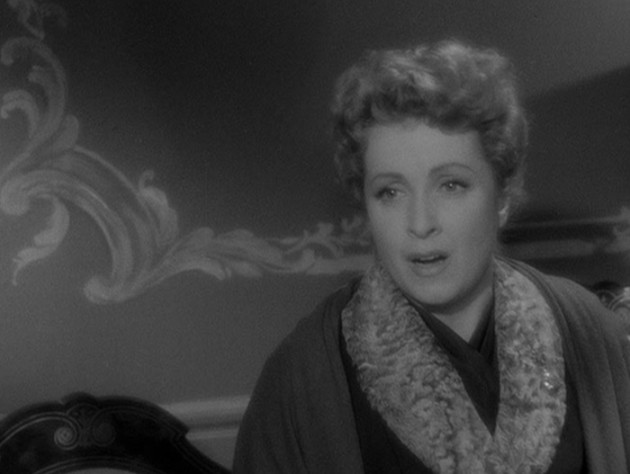
Danielle Darrieux as Comtesse Louise de…
In the same way, the nature of passion is to destroy and to consume, so is the nature of film – even if in the end the experience reveals itself as profoundly purifying, it is necessary to go through a distressful destruction in order to achieve rebirth.
As Schefer wisely puts it, “cinema is the abandonment and even the theoretical destruction of our world, a destruction we willingly accept and even pay to watch” (Vaughan 193). Our involvement with the image goes beyond the physical limits of space-time, transcending them into a much darker mental universe, beyond the dark room of the cinema and the running time of the film. As Schefer writes: “But these feelings, relying on a notion of the lonely profundity proper to our species, can’t be represented in the cinema except by way of bodies in action” (2009: 193). For this “something” to be born and for us to get the chance to meet our enigmatic bodies, there are pieces of men that must die as to assure the perpetuity of what is exterior to them. This is precisely what happens to Louise. She must progressively fall apart and fade for us to feel the terrible devastations of the heart, to experience the angst and frustration of becoming someone different than what we were supposed to be due to our own decisions – or even worse, arrive at the conclusion that this is precisely the person we should be. Slowly, Louise must leave this world and disappear into her own abyss, so that we feel with a sharp and ruthless sting that “the mundane mask that encases a restless soul” (Beylie 33) is also ours.
Therefore, we experience action and its repercussions as a sign of the invisible and of the relationship between all things. This is where I find a hidden body, my body, the body of the film: contained in gestures, words, silences, as well as in the precision of the cuts and in the transient movement of the camera as it drags everything with it. The cuts’ fierceness allied with the camera’s transience stings us in a second with its revelation, quickly and strongly, only to force us in the next second to immediately move along, to continue with the movement of the film. This is intentional, cruel and necessary. The wound stings even more without ever going through the process of healing – it hurts even more because we simply must keep going. Ophüls’ camera continues to swing, always moving forward, with no stops, intent on arriving at its fatal finale, a tragic fate that this merciless and elegant camera was aware of from the beginning.
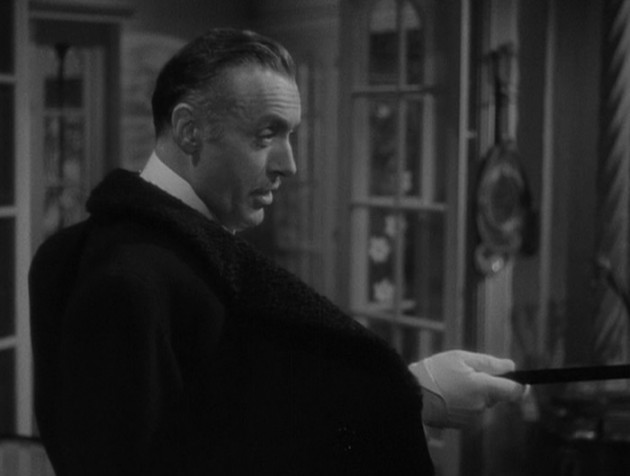
General André (Charles Boyer)
The point that this article intends to make is that behind the cinematic appearance lies a sickened depth that is led by the real movement of the film (woven by the bodies in action, by the prism of gestures and movements, by the intensity of the cuts) and ascends to the surface as a symptom. A symptom which reveals itself to us, gradually, by minuscule clues – so small and subtle, but once they are perceived, the experience can be quite fatal. This is why we talk of Ophüls, “because of the secret pulse he can imprint on beings and things” (Beylie 29), because of the sensibility with which he works the mechanisms of the classical narrative and manages to raise next to it to an inner poetic rhythm that clings to the content of narrative – a rhythm where images and words hide something other than representation. A rhythm which is constructed on the slips and slumps that frustration and tragedy creates in lives dedicated to the banal.
The main question which drives this article is: “How is this disease portrayed?” Even before that, I’ll try to begin to describe this disease that so far remains unnamed. However, we do know how beautiful it looks before our eyes, so shiny that our frail vision begins to burn. It is such a powerful virus that infects the character, the film and me in a vicious cycle where healing seems impossible. How does Ophüls, the self-described “extremely tormented and distressed man” (Beylie 33) manage to leave nobody unharmed?
I propose to address this unsettling mystery and to provide some answers concerning how this unbelievable feat is achieved: through these “pieces of men” that Ophüls builds and then destroys, through his floating camera that embodies emotions and follows the twists and turns of chance commanded by fate, and through montage where the cut points punctuate the disclosure of this “something,” giving us a glimpse of an intense revelation only to take it away in the next second, leaving us with a phantom limb pain.
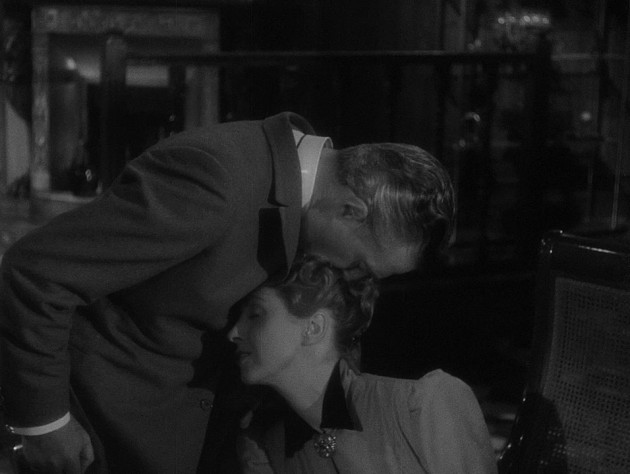
With Donati (Vittorio De Sica)
As Schefer writes, “the duration of passions can be measured only by the remnants of images—not by their cinematic duration, but by the power they have to remain, repeat, or recue” (2009: 195). The act of going to the cinema is a willing and unconscious act of destruction. And not only our world that is endangered, as previously explained, but also the cornerstone of the entire experience, the images, is on the brink of destruction. We destroy the film bit by bit, according to what it evokes in us, and we end up absorbing a few images, retained in our subconscious. Outside reason, our subjectivity summons images that haunt us, that become bonded to our being. And this insistent image that remains with us, those bits of images that have survived the destruction only in grains that assault our memory from time to time, are in Ophüls’ cinema remarkably constructed not only by the camera, but also by the montage and by the actors’ pauses and inflections, despite what some studies which focus only on Ophüls’ camera movement may suggest. All these elements of the mise-en-scène (including the objects, since, after all, a pair of earrings were enough to push Louise to her fate) are what forces us out of a conformist state of aphasia and confronts us with our enigmatic body.
Bibliography
Beylie, Claude, Ophüls, A Mulher e o Homem, pg. 31 in Max Ophüls, Cinemateca Portuguesa, Fundação Calouste Gulbenkian, Lisboa, 1983.
Conley, Tom, Reading Ordinary Viewing in Diacritics, Volume 15, Nº 2, 1985
Gallagher, Tag, Max Ophüls: A New Art – But Who Cares? in Senses of Cinema, Nº 22, 2002
Keller, Sarah, As Regarding Rhythm : Rhythm in Modern Poetry and Cinema in Intermediality: History and Theory of the Arts, Literature and Technologies, Nº 16, 2010
Kierkegaard, Søren, Ou-Ou, Um Fragmento de Vida, Relógio d’Água, Lisboa, 2013
Mandoki, Katya, An Enigmatic Text: Schefer’s Quest upon a Thing Unknown in Film-Philosophy Journal, Volume 2, Nº 1, 1998
Schefer, Jean Louis, L’homme ordinaire du cinéma, Cahiers du Cinéma, Gallimard, 1980
Schefer, Jean Louis, The Enigmatic Body: Essays on the Arts, Cambridge University Press, 2009
Vaughn, Hunter, Mutants We All: Jean-Louis Schefer and our Cinematic Civilization, Board of Regents, University of Wisconsin System, 2012
Max Ophüls, Cinemateca Portuguesa/Fundação Calouste Gulbenkian, Lisboa, 1983



